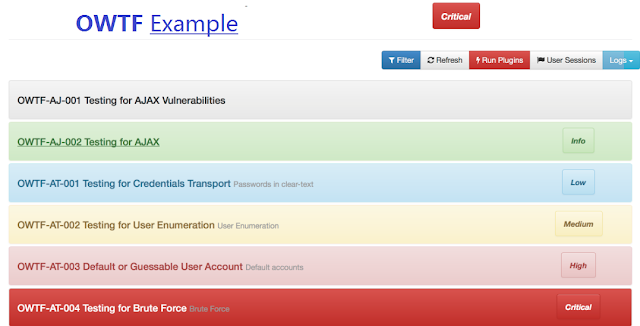OWTF- Offensive Web Testing Framework
A framework which tries to unite great tools and make PenTesting more efficient.
OWASP OWTF is a project focused on penetration testing efficiency and alignment of security tests to security standards like the OWASP Testing Guide (v3 and v4), the OWASP Top 10, PTES and NIST so that pentesters will have more time to
Note: This tool is however not a silverbullet and will only be as good as the person using it: Understanding and experience will be required to correctly interpret tool output and decide what to investigate further in order to demonstrate impact.
- See the big picture and think out of the box
- More efficiently find, verify and combine vulnerabilities
- Have time to investigate complex vulnerabilities like business logic/architectural flaws or virtual hosting sessions
- Perform more tactical/targeted fuzzing on seemingly risky areas
- Demonstrate true impact despite the short timeframes we are typically given to test.
- The tool is highly configurable and anybody can trivially create simple plugins or add new tests in the configuration files without having any development experience.
Note: This tool is however not a silverbullet and will only be as good as the person using it: Understanding and experience will be required to correctly interpret tool output and decide what to investigate further in order to demonstrate impact.
Requirements
- OWTF is developed on KaliLinux and macOS but it is made for Kali Linux (or other Debian derivatives)
- OWTF supports both Python2 and Python3.
Installation
Recommended:
Manually set up the database
- Using a virtualenv is highly recommended!
Manually set up the database
Replace the variables db_name, $db_user and $db_pass with values from the settings.py file. Make sure the values are exactly the same.
- Start the postgreSQL server,
brew install postgresql and pg_ctl -D /usr/local/var/postgres start
Kali:
sudo systemctl enable postgresql; sudo systemctl start postgresql or sudo service postgresql start
- Create the owtf_db_user user,
psql postgres -c "CREATE USER $db_user WITH PASSWORD '$db_pass';"
Kali:
sudo su postgres -c "psql -c \"CREATE USER $db_user WITH PASSWORD '$db_pass'\""
- Create the database,
macOS:
psql postgres -c "CREATE DATABASE $db_name WITH OWNER $db_user ENCODING 'utf-8' TEMPLATE template0;"
Kali:
sudo su postgres -c "psql -c \"CREATE DATABASE $db_name WITH OWNER $db_user ENCODING 'utf-8' TEMPLATE template0;\""
pip install git+https://github.com/owtf/
If you want to change the database password in the Docker Compose setup, edit the environment variables in the docker-compose.yml file.
To run OWTF on Windows or MacOS, OWTF uses Docker Compose. You need to have Docker Compose installed (check by docker-compose -v). After installing Docker Compose, simply run make compose and open localhost:8009 for the OWTF web interface.
Dependencies: Install Homebrew (https://brew.sh/) and follow the steps given below:
$ virtualenv <venv name>
$ source <venv name>/bin/activate
$ brew install coreutils gnu-sed openssl
# We need to install 'cryptography' first to avoid issues
$ pip install cryptography --global-option=build_ext --global-option="-L/usr/local/
$ git clone <this repo>
$ cd owtf
$ python setup.py install
# Run OWTF!
$ owtf
$ virtualenv <venv name>
$ source <venv name>/bin/activate
$ brew install coreutils gnu-sed openssl
# We need to install 'cryptography' first to avoid issues
$ pip install cryptography --global-option=build_ext --global-option="-L/usr/local/
$ git clone <this repo>
$ cd owtf
$ python setup.py install
# Run OWTF!
$ owtf

Features
- Resilience: If one tool crashes OWTF, will move on to the next tool/test, saving the partial output of the tool until it crashed.
- Flexible: Pause and resume your work.
- Tests Separation: OWTF separates its traffic to the target into mainly 3 types of plugins:
- > Passive : No traffic goes to the target
- > Semi Passive : Normal traffic to target
- > Active: Direct vulnerability probing
- Extensive REST API.
- Has almost complete OWASP Testing Guide(v3, v4), Top 10, NIST, CWE coverage.
- Web interface: Easily manage large penetration engagements easily.
- Interactive report:
- Automated plugin rankings from the tool output, fully configurable by the user.
- Configurable risk rankings
- In-line notes editor for each plugin.
Screenshots by OWTF.













0 Comments